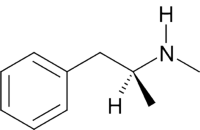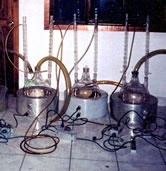Metamfetamine
Methamphetamine is a synthetic stimulant drug used for both medicinal and illicit recreational purposes. Like most stimulants, methamphetamine may induce strong feelings of euphoria and can be addictive. Pure methamphetamine is prescribed by physicians in formulations such as Desoxyn. Illicit methamphetamine comes in a variety of forms. Most coveted is a colorless crystalline solid, sold on the streets as crystal meth, glass, ice, P, Tina, Tik or numerous other street names. more...
It is also sold as less-pure crystalline powder called crank or speed, or in rock formation termed dope, raw or tweak. Yaba (Thai for "crazy medicine") is also based on methamphetamine. It has become one of the world's most prevalent illicit drugs.
Methamphetamine found on the street may be pure, or diluted with the chemicals that were used to synthesize it; in some instances, it may be diluted or cut with inert substances like inositol.
History
Methamphetamine was first synthesized in 1919 in Japan by the chemist A. Ogata. The method of synthesis was reduction of ephedrine using red phosphorus and iodine. Methamphetamine is closely related to amphetamine, which was first synthesized in the year 1887 by L. Edeleano, a German chemist. Over time, the chemical's use, distribution, and place in society changed from insignificant, to controversially beneficial, to infamous.
Later use included its distribution by the Allies and the Axis to troops during World War II under the name Pervitin. The Nazis, in particular, distributed methamphetamine widely to their soldiers for use as a stimulant, particularly to SS personnel and Wehrmacht forces in the Eastern Front. Adolf Hitler himself used to receive shots of methamphetamine from his personal physician. After World War II, a massive supply of methamphetamine, under the street name shabu, formerly stocked by the Japanese military, became available in Japan. The Japanese banned the drug soon after World War II, adding to growing yakuza businesses. Today, the underworld is still associated with the drug in Japan although strong social taboos discourage its use.
The 1950s saw a high rise in the legal prescription of methamphetamine to the American public. According to the 1951 edition of Pharmacology and Therapeutics (by Arthur Grollman), it was to be prescribed for "narcolepsy, post-encephalitic parkinsonism, alcoholism, ... in certain depressive states...and in the treatment of obesity." "Pop a pep pill" became the answer to a number of problems.
The 1960s saw the start of the significant use of clandestine manufacture to supply methamphetamine. Prior to 1983, U.S. laws prohibiting the possession of precursors and equipment for methamphetamine production were not yet in place. The 1980s saw a rise in recreational use of the drug. The December 2, 1989 edition of The Economist described San Diego, California as the "methamphetamine capital of North America."
In 1986, the U.S. government passed the Federal Controlled Substance Analogue Enforcement Act in an attempt to combat the growing problem of designer drugs. In spite of this, its use expanded throughout the rural United States—especially the Midwest and South. Growth of methamphetamine use continues into the 21st century. A decline of recreational use of methamphetamines is seen by some as a natural consequence of abuse, given the difficulties of stemming its use through law enforcement; the damage done by the chemical has been so great that some choose to avoid the drug as a result of either direct observation or word-of-mouth concerning the drug's effects. Nevertheless, many feel that current methamphetamine abuse in the U.S. still constitutes an epidemic.
Read more at Wikipedia.org



